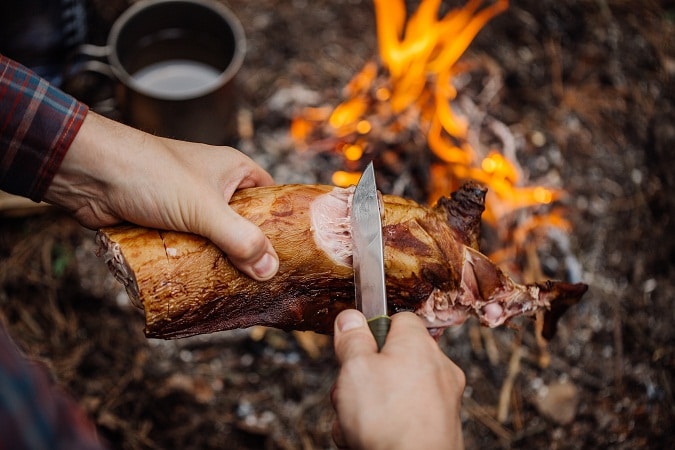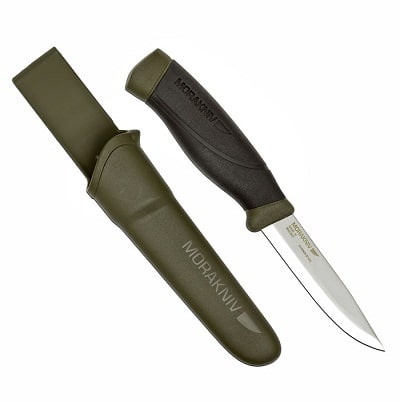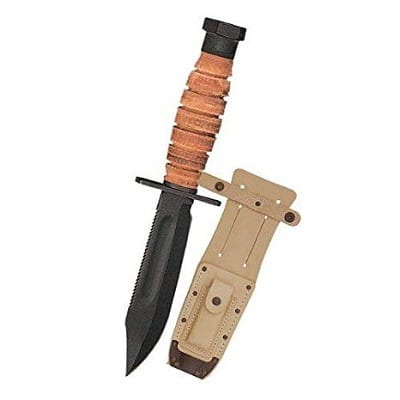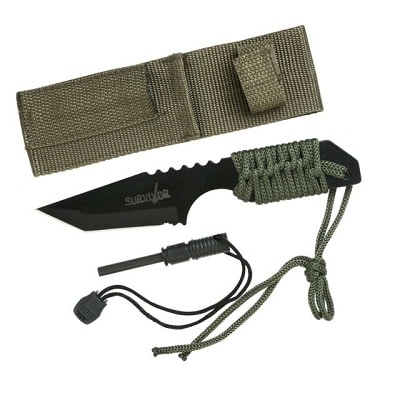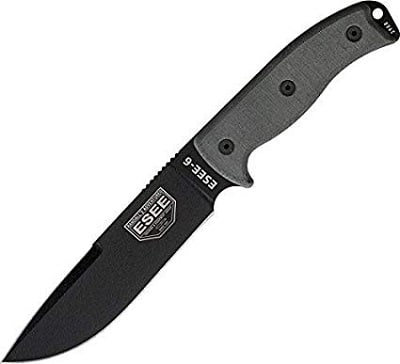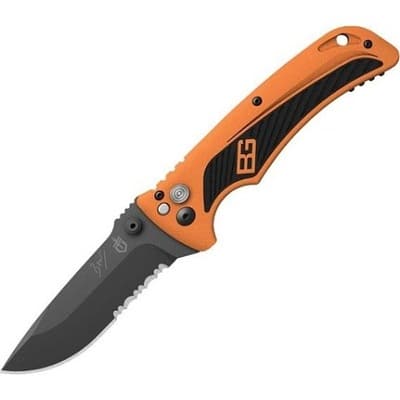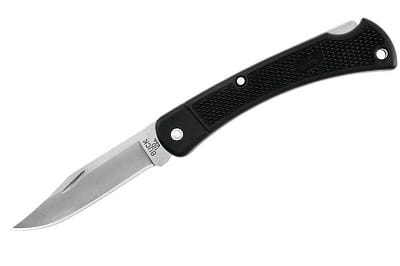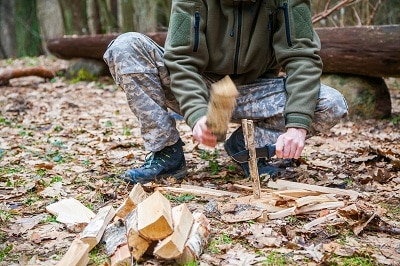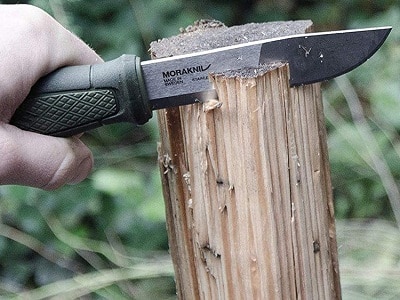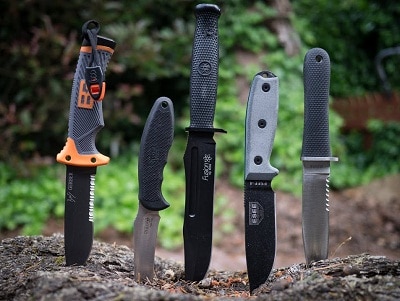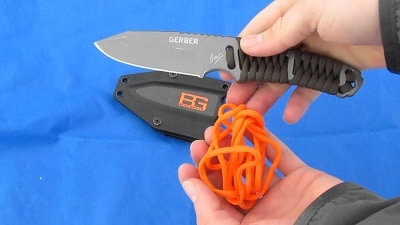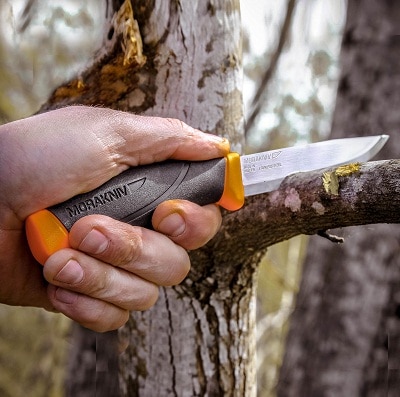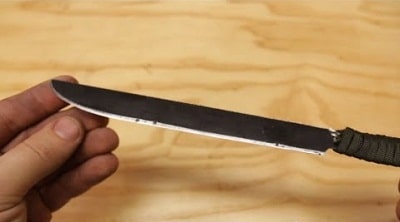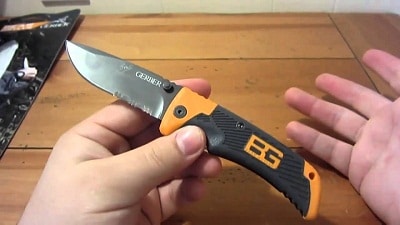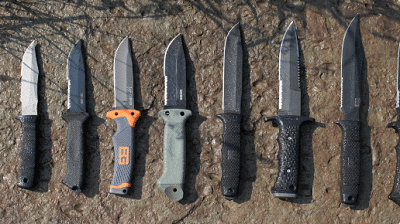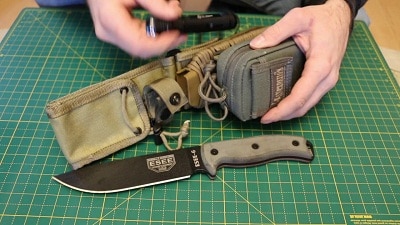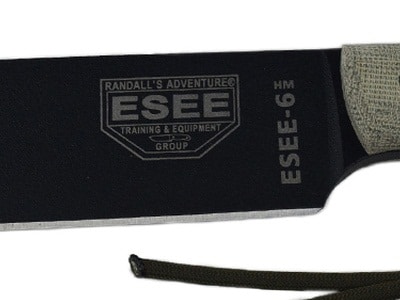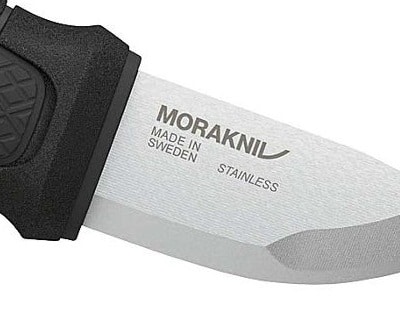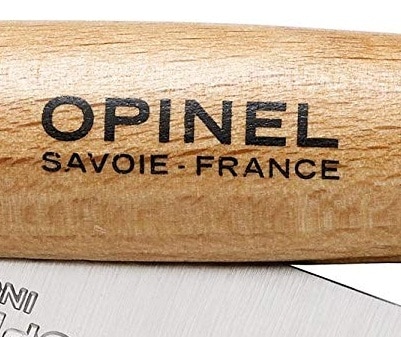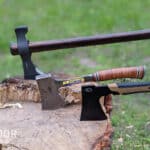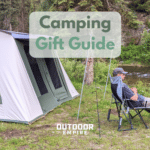A good knife is perhaps the most important survival tool you can own.
With a knife, you can:
- Make clothes
- Make shelter
- Harvest plants
- Create fishing equipment
- Craft hunting weapons
- Create traps
- Skin game
- Prepare food
- Build a fire
- Defend against attackers
- …and more
However, the emphasis is on a good knife. A bad knife is not only ineffective but also potentially dangerous.
You don’t want a knife that will break when you need to prepare kindling. You also don’t want a knife that’s too dull to cut through a rope or one that will slip out of sweaty hands.
Many folks already carry EDC knives that can, in a pinch, be used in survival situations. But outdoor survival knives are larger, tougher, and often have a fixed blade.
There are some good survival knives with a folding blade, though!
Many manufacturers make great survival knives. It’s a highly-competitive field, but the following knives stand ahead of the pack.
The 10 Best Survival Knives of 2021: Outdoor Empire Reviews
- Best Budget: Morakniv Companion
- Best Fighting Knife: Ontario 499 Air Force Survival Knife
- Best for Batoning: Fallkniven A1
- Best for Chopping: Tops Tom Brown Tracker
- Best Emergency: Survivor HK-106320-A
- Best for the Money: Ka-Bar Becker BK-22 Campanion
- Best Overall: ESEE 6P
- Best Budget Folding: Gerber Bear Grylls Survival AO Knife
- Best Folding for the Money: Buck Knives 110 LT Drop Point Folding Hunter
- Best Overall Folding: Opinel No. 8 Outdoor
| Category | Best for Bushcrafting | Best for the Money | Best Overall Folding |
|---|---|---|---|
| Product | 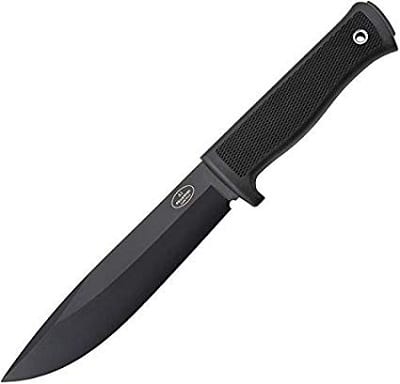 | 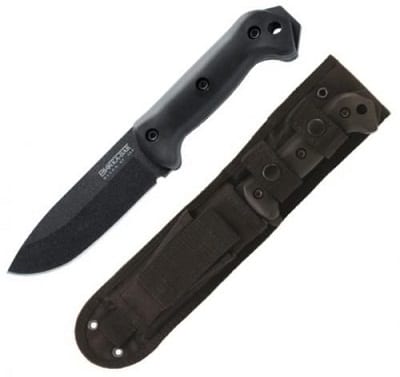 | 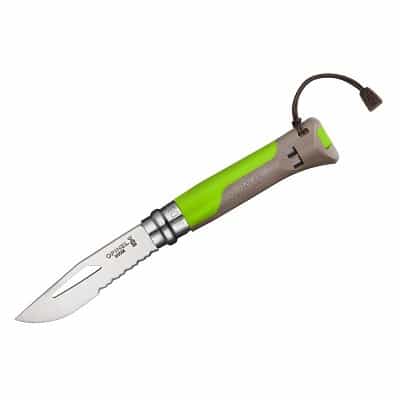 |
| Blade Shape | Drop point | Drop point | Yatagan with serrations |
| Blade Material | Laminated VG10 | 1095 Cro-Van stainles steel | Sandvik 12C27 stainless steel |
| Blade Length | 6.2 in | 5.25 in | 3.35 in |
| Overall Length | 11 in | 10.5 in | 0.1 in |
| Handle Material | Kraton | Ultramid | Polymer |
| Cost | Check Price | Check Price | Check Price |
1. Best Budget Survival Knife: Morakniv Companion
- Blade Shape: Clip point
- Blade Material: Sandvik 12C27 stainless steel or 1095 carbon steel
- Blade Length: 4.1″
- Blade Thickness: 0.1″ or 0.08″
- Overall Length: 8.6″
- Handle Material: Rubber and polymer
- Handle Colors: Black, cyan, desert tan, gray, green, magenta, military green, navy blue, orange
- Fixed or Folding? Fixed
- Misc: Polymer sheath
- Tang: 3/4
Overview
Let’s start with what is quite possibly the most recommended bushcrafting knife: the Morakniv Companion.
Mora makes no-nonsense, inexpensive blades designed for people who need to survive in the woods. There’s a lot of overlap between bushcrafting and survival because bushcrafting is two-thirds surviving, one-third hobby.
The Morakniv Companion is available with two types of steel: 12C27 stainless steel or 1095 carbon steel, giving you options whether you prefer corrosion resistance or a better edge.
The handle is polymer and rubber, making it comfortable and grippy whether hot or cold, wet or dry.
The blade is well sized for both light and heavy tasks. You can chop through a branch and then whittle it into a feather stick.
However, don’t baton with a Companion unless you have a backup knife. The tang only goes three-quarters of the way through the handle.
The Companion has other versions as well, including the Heavy Duty and Rescue.
Pros
- Good Swedish steel
- Inexpensive
- Versatile
Cons
- Doesn’t come sharp
- Lacks a full tang
Recommendation
Every bushcrafter or prepper should own a Morakniv companion. It’s the standard by which other survival knives are measured and is far cheaper than most other quality blades.
2. Best Fighting Knife: Ontario 499 Air Force Survival Knife
- Blade Shape: Clip point
- Blade Material: 1095 carbon steel
- Blade Length: 5″
- Blade Thickness: 0.1875″
- Overall Length: 9″
- Handle Material: Leather
- Fixed or Folding? Fixed
- Tang: Rat-tail
- Misc: Leather sheath with sharpening stone
Overview
The Ontario 499 Air Force survival knife was designed as a piece of emergency kit for pilots who might be shot down over enemy territory.
It’s similar to other Ontario knives, such as the USMC fighting knife, but is made more for survival than for fighting. You can still stick a pig with it, though!
The 5-inch blade is thick enough to survive cutting a hole through an aircraft’s skin. It’s more than up to the task of processing firewood. Though, the tang is rat-tail instead of full, so while it can baton through small logs, you won’t want to do this constantly.
The handle is made from leather and provides ample grip through a wide range of conditions. The blade is very thick at 0.1875 inches. The clip point is great for stabbing. The back is serrated but not deeply enough to use it as a wood saw.
The pommel is heavy steel, so you can use it as a hammer if you need to.
The leather sheath even includes a sharpening stone, which you’ll need to maintain the 1095 carbon steel edge.
Pros
- Heavy-duty pommel
- Sharpening stone in sheath
- Very tough blade
Cons
- Heavy
Recommendation
The Ontario 499 Air Force survival knife is an old-school knife that’s been used by everybody from cub scouts to military pilots to thrive in the woods.
3. Best Survival Knife for Batoning: Fallkniven A1
- Blade Shape: Drop point
- Blade Material: Laminated VG10
- Blade Length: 6.2″
- Blade Thickness: 0.23″
- Overall Length: 11″
- Handle Material: Kraton
- Fixed or Folding? Fixed
- Tang: Full
- Misc: Zytel sheath
Overview
The Fallkniven A1 blends Japanese steel with Swedish design for an amazing survival knife that can handle any task you demand of it.
You can tell as soon as you hold this knife that a lot of thought went into its design. It balances well and feels natural in the hand. The shape is simple but very effective.
The blade is 6.2 inches long. This may be longer than ideal for some tasks, but the A1 will still work for them. The modified drop point gives you control to the very end.
What’s notable about the blade is its width. At almost a quarter inch thick, it’s extremely tough. A Kraton handle covers the full tang. Combine the tang and blade thickness and you have a survival knife you can use as a bludgeon.
This and the straight back almost all the way from tip to pommel lets you baton this blade through any wood in the world!
There’s even an exposed section of the tang, so you can use the pommel as a hammer.
The A1 has a VG10 high-carbon steel core covered in 420J2 stainless steel to blend the best qualities of both stainless and carbon steels.
Pros
- Laminated steel blade
- Good for all survival knife tasks
Cons
- Expensive
- Some users have reported chips in the edge
Recommendation
The Fallkniven A1 is one of the best survival knives and is the toughest one you can find, if you like whacking your knife to cut through logs.
4. Best Survival Knife for Chopping: Tops Tom Brown Tracker
- Blade Shape: Tracker
- Blade Material: 1095 carbon steel
- Blade Length: 6.25″
- Blade Thickness: 0.25″
- Overall Length: 11.875″
- Handle Material: Micarta
- Fixed or Folding? Fixed
- Tang: Full
- Misc: Kydex sheath
Overview
Renowned tracker Tom Brown Jr. designed the Tracker knife as an all-purpose survival knife after being questioned if the perfect survival knife existed. It eventually made its way into a 2001 movie called The Hunted.
The 6.25-inch blade has a unique design with a semi-circular front, hooked midsection, and sawback. The idea is for this knife to be able to handle any task you might need in the woods.
It excels at chopping and is basically half survival hatchet. The other tasks, though?
Well, the hooked portion is a passable draw knife. You can carve feather sticks because the micarta handle and jimping give you good control. However, the knife is overall balanced too far forward for delicate tasks.
The saw portion is good for notching but not as good for actually sawing. It does, however, chew through any piece of wood you’ll use to baton with this knife, which seems counterproductive.
Overall, the Tracker knife is a passable multipurpose blade that shines best when chopping.
Unlike many knives, it comes with a manual that explains all the ways you can use this knife.
Pros
- Comes with a manual
- Great at chopping
- Multipurpose
Cons
- Poor batoning because of the sawback location
- Somewhat unwieldy for finer tasks
- Very expensive
Recommendation
The Tracker knife is controversial in the bushcrafting and survival world. Some people love it and others hate it. It’s still a great chopping knife, though!
5. Best Emergency Survival Knife: Survivor HK-106320-A
- Blade Shape: Tanto
- Blade Material: Stainless steel
- Blade Length: 3″
- Blade Thickness: 0.16″
- Overall Length: 7″
- Handle Material: Nylon cord
- Fixed or Folding? Fixed
- Tang: Full
- Misc: Nylon sheath, firestarter rod
Overview
The Survivor HK-106320-A is a bit small for a survival knife. The blade is made from an unstated form of stainless steel, so that’s not the best either, though it is in an effective Tanto style and has good jimping.
The Survivor HK-106320-A is not a good primary survival knife.
However, it’s both easily concealed and very cheap.
Under ten dollars.
In fact, you can buy an eight-pack of these knives and still not spend as much money as some of the knives on this list!
This makes the Survivor HK-106320-A an excellent backup or emergency knife. Especially with the included magnesium fire starter rod and nylon cord handle, which unravels for when you need cordage.
You can toss one in your backpack, glovebox, boot, each pair of pants you own, and anywhere else you can think of, so you will always have this knife no matter what happens to you.
It doesn’t matter if you own the best survival knife if you’ve left it at home. The best survival knife is the one you have with you, and it’s easy to have a Survivor HK-106320-A with you.
Pros
- Comes with a magnesium fire starter
- Concealable
- Extremely inexpensive
- Removable cord handle
Cons
- Not a good primary knife
- Small
Recommendation
The Survivor HK-106320-A may not be the biggest or strongest survival knife out there, but it’s small enough to hide anywhere and is cheap enough for you to have one, or eight, on hand.
6. Best Survival Knife for the Money: Ka-Bar Becker BK-22 Campanion
- Blade Shape: Drop point
- Blade Material: 1095 Cro-Van stainles steel
- Blade Length: 5.25″
- Blade Thickness: 0.25″
- Overall Length: 10.5″
- Handle Material: Ultramid
- Fixed or Folding? Fixed
- Tang: Full
- Misc: MOLLE compatible polyester sheath
Overview
No, you read that correctly: This knife by Ka-Bar is the Becker BK-22 Campanion. Not “companion.” Even if some of the official materials says differently. There was an intern who thought they were oh-so-clever by using a spellchecker, I imagine.
The Campanion is a heavy-duty survival knife designed to “work for a living,” according to Ka-Bar.
The blade is 5.25 inches long and a quarter inch thick. It has a fat drop point and is 1.625 inches wide, making this a hefty boy. It’s good for chopping, prying, and batoning.
The flat grind is also good for finer tasks, such as skinning game and preparing food, even though the knife is large.
The Campanion is well balanced but might be too large for people with small hands.
The holster is MOLLE compatible, making this knife a good match for a tactical backpack. There are actually two Campanion models:
- BK-2 with a hard-plastic sheath
- BK-22 with a soft polyester sheath
I prefer the softer sheath because it has a pocket for a sharpening stone. That stone isn’t included, unfortunately.
Pros
- Comes with your choice of hard or soft sheath
- Full tang with exposed section for hammering
- Thick and heavy blade that can baton, chop, and pry
Cons
- Delicate tasks might be difficult
- Might be too large for small hands
Recommendation
The Ka-Bar Becker BK-22 Campanion is a great survival knife that can survive whatever you throw at it, but it might not be a good fit for every hand.
7. Best Overall Survival Knife: ESEE 6P
- Blade Shape: Drop point
- Blade Material: 1095 carbon steel
- Blade Length: 6.5″
- Blade Thickness: 0.1875″
- Overall Length: 11.75″
- Handle Material: Micarta
- Fixed or Folding? Fixed
- Tang: Full
- Misc: Molded polymer sheath
Overview
The ESEE-6P is not a very impressive looking knife. However, it hits every point you need for a survival knife.
It has a long, wide blade made from 1095 carbon steel that can hold a good edge and still be used for prying and batoning. There’s subtle yet effective jimping on the spine for greater control. A black-powder coating protects against corrosion.
The Micarta handles are removable if you need to clean blood from underneath them. They cover almost all of the tang except for the lanyard hole and a portion you can use for hammering.
The blade may be wide, but the 6P is not a heavy knife. It’s heavy enough for chopping, sure, but it won’t be too heavy to wear you out. In fact, it’s surprisingly effective at finer tasks like whittling!
The 6P comes with a molded polymer sheath that retains the knife well. It has a belt clip instead of a belt loop, if that matters to you.
The only downside to this blade is minor. Both the blade and handles are very hard, so you feel the full impact of every swing.
Finally, ESEE has a wonderful warranty. If you break your 6P for any reason, they will repair or replace it, even if you’re not the original owner!
Pros
- Excellent warranty
- Hammer section on pommel
- Jimping
- Surprisingly lightweight
Cons
- Expensive
- Little shock absorption
Recommendation
The ESEE 6P is my favorite of all survival knives. It’s strong, lightweight, comfortable in the hand, and very versatile.
8. Best Budget Folding Survival Knife: Gerber Bear Grylls Survival AO Knife
- Blade Shape: Drop point with serrations
- Blade Material: 7Cr17MoV stainless steel
- Blade Length: 3″
- Blade Thickness: 0.125″
- Overall Length: 7.4″
- Handle Material: Fiberglass-reinforced nylon with rubber overmolding
- Fixed or Folding? Folding
- Misc: Spring assisted opening
Overview
I’m typically not a fan of Bear-Grylls-branded survival items, but the Gerber Bear Grylls Survival AO Knife surprised me with its features and quality.
One of my problems with folding knives is how most of them have a liner lock. Liner locks require you to put your finger in the blade’s path as you start to fold the blade closed.
Yikes!
The Bear Grylls Survival AO knife, though, has a plunger lock. That’s a button on the side, greatly reducing your chances of slicing your finger open during a survival situation.
Opening the knife is easy too, with the FAST 2.0 spring-assisted opening mechanism. Undo the safety and flick the knife open using either of the two thumb studs.
This covers the second major problem with folding knives in that they’re rarely as ambidextrous as fixed blades.
The blade is Chinese 7Cr17MoV stainless steel that’s good enough. Not the best, but not the worst.
The handle is bright orange fiberglass-reinforced nylon and rubber. You’ll have a hard time losing this knife.
Keep in mind that, as a folding knife, you won’t be able to abuse this knife as much as a fixed blade.
Pros
- Comfortable handle
- FAST 2.0 assisted opening
- Plunger lock
Cons
- Break-in required
Recommendation
The Gerber Bear Grylls Survival AO Knife is a good folding knife for survival operations and is pretty inexpensive as well.
9. Best Folding Survival Knife for the Money: Buck Knives 110 LT Drop Point Folding Hunter
- Blade Shape: Drop
- Blade Material: 420HC stainless steel
- Blade Length: 3.75″
- Blade Thickness: 0.12″
- Overall Length: 8.5″
- Handle Material: Polyester
- Fixed or Folding? Folding
- Misc: Nylon sheath
Overview
Buck Knives’ 110 Folding Hunter is a 50-year-old design that’s still used by hunters and outdoorsmen today. The drop point LT version is even better for survival situations.
The normal 110 has ebony scales with brass bolsters and also has a clip point. The LT has a textured polyester handle that reduces weight and increases weather resistance.
It also has a drop point, which is not quite as effective for fine detail work, such as carving, but it’s more durable for survival tasks. You won’t baton a folder, but this version of the Folding Hunter can survive tougher tasks than many other folding knives.
The blade is 3.75 inches long and is made from 420HC stainless steel. Buck uses a proprietary heat-treating method to make their 420HC superior to the same steel by other manufacturers. It’s more corrosion and wear resistant.
Also, the lock is on the back, not in the blade’s path, keeping you safe.
Pros
- Lightweight and durable
- Tough blade design
Cons
- Slightly annoying hump where the blade meets the handle on the back side
Recommendation
Buck Knives 110 LT Drop Point Folding Hunter is a modern version of a classic knife that’s a good emergency knife and is surprisingly tough for a folding knife.
10. Best Overall Folding Survival Knife: Opinel No. 8 Outdoor
- Blade Shape: Yatagan with serrations
- Blade Material: Sandvik 12C27 stainless steel
- Blade Length: 3.35″
- Blade Thickness: 0.1″
- Overall Length: 7.625″
- Handle Material: Polymer
- Fixed or Folding? Folding
- Misc: Virobloc collar safety, lanyard, built-in whistle and shackle key
Overview
Opinel knives became a classic 100 years ago. They are folding knives distilled into their most essential elements and made from only five parts. The Opinel No. 8 Outdoor is a modern version—more advanced, but not annoyingly so.
Opinel No. 8 is the most popular size, with a 3.25-inch blade. The Outdoor Range version has Sandvik 12C27 stainless steel, which can get very sharp while resisting corrosion, unlike the classic wood-handled “Carbone” with high-carbon steel.
The blade’s shape is similar to that of a Turkish saber, with a mild concave section then convex tip shaped halfway between a clip and drop point. The Outdoor Opinel is partially serrated, which increases its versatility. There is also a 4 mm to 10 mm shackle key.
This all contributes to a blade that cuts well above its weight class. And it’s in the featherweight class; the Opinel No. 8 Outdoor weighs 2.2 ounces!
The handle is made from black and orange polymer. It has subtle curves which make the knife comfortable in your hand, and unlike the classic Opinels, is not prone to swelling in humid weather. It has a whistle near the end.
You have to manually unlock, unfold, then lock the blade in order to use it. The Virobloc safety collar contributes to this knife’s strength but also makes it slow to use.
Pros
- Above-average cutting ability
- Built-in whistle and shackle key
- Inexpensive
- Strong Virobloc twisting safety collar
- Weighs just over than 2 ounces
Cons
- Slow to open and close.
Recommendation
The Opinel No. 8 Outdoor is a survival-oriented version of a classic knife that’s best for everyday carry. It has served many bushcrafters in the field. Like any folding knife, it shouldn’t be your primary survival knife, but it will work if you’re caught in the wild with nothing else.
Why Do You Need a Quality Survival Knife?
Buying a knife specifically for survival situations may not seem like the best idea.
Nobody plans to get into a survival situation. Except for bushcrafters. They do so purposefully to practice survival skills, so they are always prepared.
If an emergency happens and you’re thrust into a survival situation, you’ll be glad you spent the money on a good wilderness survival knife!
You don’t have to spend massive amounts of money preparing for an emergency. All you should do is buy one or two survival knives. Put one in your go-bag or bugout bag, and put the other in your vehicle.
That way, if the unthinkable happens, you’ll be able to grab your good knife at the same time you get your other survival supplies.
You should have an everyday carry blade on you as well, but you don’t want to rely on that knife in a survival situation.
What Are the Benefits of a Survival Knife Over a Normal Knife?
Normal knives are not designed to be abused for a week straight.
Survival knives are tougher than your standard EDC knife. One of the most common metrics people use to judge blades is whether or not you can baton with them.
Batoning is when you split firewood by cutting into the top with the knife and then hitting the tip and handle, alternating each hit, so the blade descends through the log and forces it apart.
This is one of the most demanding tasks you can ask of a knife, and it requires a thick blade and a strong tang.
Let’s not forget chopping, digging, hammering, breaking apart joints, and other similar tasks. Your EDC knife is not a safe choice for these, but a survival knife is up to the challenge!
How to Choose A Top Survival Knife?
Wilderness survival knives are a must for anyone who wants to not die in the woods. But not every knife is good for everyone, except maybe the Morakniv Companion or ESEE-6P.
Even then, which one should you choose?
Other than the flippant answer of “both,” you should think long and hard about any item you’re going to use to survive. SHTF knives are no different.
Fixed vs. Folding
I’m not going to beat around the bush (that’s what machetes are for). You want your main survival knife to have a fixed blade.
There are great folding knives out there, but folding knives have two disadvantages compared to fixed blades:
- They are less safe.
- They do not have tangs.
Those two reasons tie into each other.
If you’re subjecting your knife to stress, such as the digging or prying you might need to do in a survival situation, much of that force is transferred into the tang.
Folding blades do not have tangs; they have locks. Even the strongest lock is much weaker than a tang.
If you try to baton with a folding blade, you might break the lock.
Also, it’s easy to get your fingers caught between the edge and the handle when closing a folding blade. If you’re trying to survive, then you should minimize all chances of injury, especially to your hands.
However, folders do have their place. You’re more likely to carry a folding knife, they make excellent backup blades, and they are better for more delicate tasks such as food preparation and making feather sticks.
So, it’s a good idea to have a survival folding blade alongside your primary fixed blade knife.
Blade Shape
An outdoor knife’s shape does affect whether it’s good for general use or for survival.
Tip
Generally, for a survival knife, you want a thicker, stronger tip.
This generally means you should go with a drop point knife instead of one with a clip point. That’s why the normal Buck Knives 110 Folding Hunter LT didn’t make the list. The clip point would be less likely to survive the constant stress.
Edge: Plain vs. Serrated
Most survival knives have a plain edge.
Serrations may seem like a good idea, but they interfere with batoning. Serrations are also more difficult to sharpen in the field, so you’ll generally want to stick with the easy-to-sharpen plain edge.
However, serrations are good at cutting through rope.
Since you won’t be batoning with a backup folding blade, you might as well choose one with serrations.
Steel Type
There are two main types of steel in the knife world: stainless steel and high-carbon steel
There are many types of steel within those two categories, but for brevity’s sake, those are the two options.
Generally, stainless steel is more corrosion resistant. You don’t need to care for it as much, and while it will only have an okay edge, that edge will stay sharp for longer.
High-carbon steel is the opposite. It’s prone to rusting unless you keep it clean and oiled. However, high-carbon steels can have extremely sharp edges that are easy to sharpen.
Handle Material
Survival knife handles need to be designed for utility, not aesthetics. As such, none of the knives listed above have wooden handles.
Wood is beautiful but gets slick when you’re sweaty. This is no good if you are working in a humid area, in the rain, or when under pressure.
Synthetic handles such as Micarta provide a better grip when wet and are less likely to get damaged by cold, heat, or moisture.
Tang
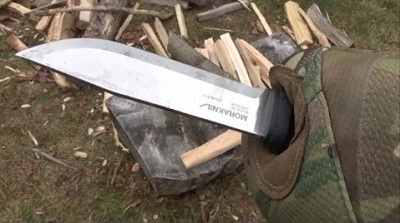
The bigger the tang, the better the wilderness knife.
Rat-tail tangs are thin pieces that go through the center of the handle. This presents a weak point that’s prone to breaking, but this won’t be a problem with a well-made knife.
A three-quarter tang is better than a rat-tail, but batoning with one is iffy. Especially if you strike the handle past the tang.
A full tang is best. There are no weak points in the knife, so it can handle all the abuse. Some full-tang knives even have a pommel that’s not covered by the handle, so you can use the knife as a hammer!
Size
Most survival blades should be 4 to 7 inches long.
Shorter blades allow for more dexterous movement but suffer in versatility. Longer blades are better for chopping and skinning but start to get more cumbersome, again losing versatility.
Some people claim 5 to 6 inches to be the sweet spot. Other people say that if you want to go larger than 4 inches, you should switch to a different tool.
Part of figuring out the best knife size is personal preference and depends on your hand size. A giant knife may work for you if your hand is larger than most people’s faces. If you’re petite, then get a smaller knife.
It’s a good idea to head to a store and try out different-sized blades to see which ones feel right to your hands.
Extra Features
Wilderness survival knives can have features beyond a blade and handle.
Sheaths are almost always nice. You’ll need to safely carry that knife around.
Other features are personal preference. Having a built-in whistle is nice but rarely important (you should have one of those anyway).
If you can, though, I would recommend getting a knife with jimping. Jimping is a textured, scalloped, or dully-serrated area on the blade’s spine. It gives your thumb more grip and increases your control over the knife, making it both safer and more effective.
Top Survival Knife Brands
ESEE
ESEE’s 6P knife claims the top spot in this list. What has the company done to attain this achievement?
Well, ESEE has been actively engaged in survival and wilderness sports for over two decades. It all started in Peru with Randall’s Adventure and Training.
Randall’s Adventure and Training was established to provide high-quality wilderness survival instruction to citizens of Peru and visitors from abroad. Jungle survival is a step above forest survival, so Jeff Randall and his partner Mike Perrin had to know their stuff.
They knew enough to get a contract with the Peruvian Air Force’s School of Jungle Survival, or Escuela De Supervivencia En La Selva.
With all of their knowledge and their desire to improve the wilderness survival community’s ability to survive anywhere, Randall and Perrin set out designing knives. And they designed some good knives.
They designed several knives for the Ontario Knife Company, including the RAT line. They also designed a knife for TOPS Knives. Then they decided to produce their own knives, and ESEE was born.
ESEE’s staff still practices survival and outdoor adventure and continue to produce some of the best survival knives in the world, without any of the fancy trappings that cause prices to skyrocket.
When you buy an ESEE knife, you know you’re paying for quality.
ESEE also works with a search-and-rescue organization based out of Alabama called RAT-SAR. RAT-SAR teaches participants to survive in some of the most dangerous places on Earth while rescuing other people from perishing in the wild.
Morakniv
Morakniv, commonly called Mora, is based in Mora, Sweden. They were established in 1891 in a country with one of the strongest wilderness exploration traditions in the world.
Though Morakniv itself was “only” established in 1891, the city of Mora was already well known as a knifesmith’s capital, so today’s Morakniv has over 400 years of experience behind it.
Mora’s knives are no-nonsense blades that are 100% utility. They are made with high-quality Swedish steel and handles meant to last. Because of this, Mora has a great reputation among bushcrafters and other wilderness explorers.
Mora also produces knives for cooks, fishermen, woodworkers, and even ranchers. But they are best known for their survival blades, especially the Companion.
Every time someone asks what knife they should buy for an outdoor hobby, Morakniv is mentioned.
Opinel
Unlike ESEE and Morakniv, Opinel didn’t start by making survival knives.
Their knives were for French peasants.
Opinel was established in 1890 by Joseph Opinel when he started making and selling penny knives for working folks. They became wildly popular, and he expanded his range by making the knife longer or shorter.
Every one of Opinel’s knives have a number. No. 8 is the most popular size, and the 8 refers to how it’s 8 centimeters long.
No. 9 and No. 10 are also good for outdoor use, by the way. But only the No. 8 is available with the rugged polymer handle.
Until 1955, Opinel knives were made with just four parts. Marcel Opinel improved the knives that year by inventing the Virobloc safety, which not only made the knives safer but also stronger.
The classic Opinel knife has a high carbon steel blade and beechwood handles. These are simple, beautiful knives. While good for EDC, they are not as good for survival work where you’ll be spending lots of time in the wet outdoors.
No metal or plastic separates the blade from the wood, so it can absorb moisture then hold it against the blade, causing rust.
The Outdoor model doesn’t have this problem. However, it lacks another aspect which has made Opinel so beloved: easy modifications.
Many people customize their Opinel’s handle. You can reshape it, add decorations, or increase the functionality by adding a lanyard hole.
So, while the classic Opinels aren’t optimal survival knives, they’re still timeless pocket knives!
You might also want to look into these:
Knife sharpeners

